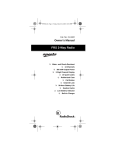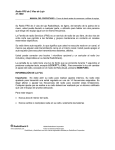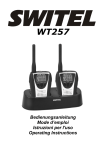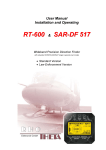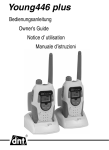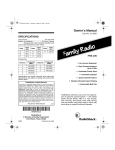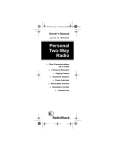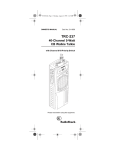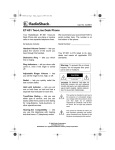Download Ricoh 21-1812 User's Manual
Transcript
21-1812.fm Page 1 Thursday, August 5, 1999 3:06 PM Owner’s Manual Cat. No. 21-1812 Two-Way Personal Radio n No License Required! n 14 Channels n Quiet Code Feature n Backlit Display n Water and Shock Resistant for Sport Use n 300 mW Output Power n Call Button n Auto Squelch n Built-In Charger 21-1812.fm Page 2 Thursday, August 5, 1999 3:06 PM INTRODUCTION RadioShack welcomes you to the next generation of personal communication — the Family Radio Service (FRS). FRS is a new license-free, two-way, short-range voice radio service that lets families and groups keep in touch with each other on specific reserved channels. Your RadioShack Two-Way Personal Radio is a lightweight, palm-sized radio that you can carry almost anywhere. It has 14 channels and 8 different quiet codes. If someone else is using the channel you selected, select another channel or use the quiet feature (see “Using Quiet Codes” on Page 12). You can talk with a person who has an FRS radio if both radios are tuned to the same channel and quiet code. Your radio has auto-squelch, which means you won’t hear anything on a channel unless someone is transmitting nearby on the same channel. You can turn off autosquelch to hear weaker, distant transmissions (see “Auto-Squelch” on Page 13). We recommend you record your radio’s serial number here. The number is on the radio’s back panel. Serial Number: © 1998 Tandy Corporation. All Rights Reserved. RadioShack is a registered trademark used by Tandy Corporation. 2 21-1812.fm Page 3 Thursday, August 5, 1999 3:06 PM PREPARATION INSTALLING BATTERIES Your radio uses three AA batteries (not supplied) for power. We recommend alkaline batteries, such as RadioShack Cat. No. 23-552. You can also use rechargeable nickel-cadmium batteries (Cat. No. 23-125 or 23-149). Before you use nickel-cadmium batteries, you must charge them (see “Charging Nickel-Cadmium Batteries” on Page 4). Follow these steps to install batteries. 1. Be sure the radio is off, then pull down the latch at the bottom of the radio and remove the battery compartment cover. 2. Use a pointed object such as a pen to set CHRG inside the compartment to OFF (for alkaline batteries) or ON (for nickel-cadmium batteries). 3 21-1812.fm Page 4 Thursday, August 5, 1999 3:06 PM Warning: Never set CHRG to ON if you use non-rechargeable batteries. Non-rechargeable batteries can get hot or explode if you try to recharge them. 3. Install the batteries as indicated by the polarity symbols (+ and –) inside the compartment. Then replace the cover. Caution: Do not mix old and new batteries or different types of batteries. The radio’s range decreases as battery power decreases. For the longest range, keep fresh batteries installed in the radio. When flashes, replace (or recharge) the batteries. Charging Nickel-Cadmium Batteries You can recharge nickel-cadmium batteries while they are in the radio. Set CHRG to ON, install the nickel-cadmium batteries in the radio, and connect an external AC or DC adapter to the radio’s DC 9V jack (see “Connecting an AC Adapter” on Page 6 or “Connecting a DC Adapter” on Page 7). 4 21-1812.fm Page 5 Thursday, August 5, 1999 3:06 PM Warning: Do not connect either adapter to the radio if non-rechargeable batteries (such as alkaline batteries) are installed and CHRG is set to ON, or if you are unsure of the switch’s position. Non-rechargeable batteries can get hot or explode if you try to recharge them. Before using nickel-cadmium batteries for the first time, charge them for at least 10 hours to bring them to a full charge. Discharged batteries take about 10 to 18 hours to fully recharge. If you use the radio while the batteries are charging, charging takes longer. Notes: • Nickel-cadmium batteries last longer and deliver more power if you occasionally let them fully discharge by using the radio until flashes. • To prevent damage to nickel-cadmium batteries, never charge them in an area where the temperature is above 113°F (45°C) or below 40°F (4.4°C). Important: At the end of a rechargeable battery’s useful life, it must be recycled or disposed of properly. Contact your local, county, or state hazardous waste management authorities for information on recycling or disposal programs in your area. Some options that might be available are: municipal curb-side collection, drop-off boxes at retailers such as your local RadioShack store, recycling collection centers, and mail-back programs. 5 21-1812.fm Page 6 Thursday, August 5, 1999 3:06 PM Connecting an AC Adapter You can charge the radio from a standard AC outlet using an optional AC adapter (such as Cat. No. 273-1665). Warning: Do not use an AC adapter’s polarized plug with an extension cord, receptacle, or other outlet unless the blades can be fully inserted to prevent blade exposure. Cautions: • The recommended AC adapter supplies 9 volts and delivers at least 300 milliamps. It has a barrel plug with a center negative tip that correctly fits the radio’s DC 9V jack. Using an adapter that does not meet these specifications could damage the radio or the adapter. • To protect your radio and AC adapter, always plug the adapter into the radio before you plug it into the AC outlet, and always unplug the adapter from the AC outlet before you unplug it from the radio. • Make sure CHRG inside the battery compartment is set to ON and nickelcadmium batteries are installed (see “Installing Batteries” on Page 3). 1. Plug the adapter’s 3.4 mm outside diameter/1.3 mm inside diameter barrel plug into your radio’s DC 9V jack. 6 21-1812.fm Page 7 Thursday, August 5, 1999 3:06 PM 2. Plug the other end of the adapter into a standard AC outlet. The CHARGE indicator lights. Connecting a DC Adapter You can charge the radio from your vehicle’s cigarette-lighter socket using an optional DC adapter, such as Cat. No. 2701560 or 273-1810. Cautions: • The recommended DC adapter supplies 9 volts and delivers at least 300 milliamps. It has a barrel plug with a center negative tip that correctly fits the radio’s DC 9V jack. Using an adapter that does not meet these specifications could damage the radio or the adapter. 7 21-1812.fm Page 8 Thursday, August 5, 1999 3:06 PM • To protect your vehicle’s electrical system, always plug the adapter into the radio before you plug it into your vehicle’s cigarette-lighter socket. Always unplug the adapter from the vehicle’s cigarette-lighter socket before you unplug it from the radio. • Make sure CHRG inside the battery compartment is set to ON and nickelcadmium batteries are installed (see “Installing Batteries” on Page 3). 1. Set the adapter’s voltage switch to 9V. 2. Connect the 3.4 mm outer diameter/ 1.3 mm inner diameter tip to the adapter cord, matching TIP to –. 3. Plug the adapter’s barrel plug into your radio’s DC 9V jack. 4. Plug the other end of the adapter into your vehicle’s cigarette-lighter socket. The CHARGE indicator lights. Note: If the radio does not charge properly, unplug the adapter from the cigarette-lighter socket and clean the socket to remove ashes and debris. 8 21-1812.fm Page 9 Thursday, August 5, 1999 3:06 PM ATTACHING THE BELT CLIP Use the supplied belt clip to take your radio along when you are on the go. Use a coin or screwdriver to screw the belt clip to the radio, then slide the clip over your belt or waistband. CONNECTING AN OPTIONAL MICROPHONE/ SPEAKER To use the radio privately, connect an optional headset with microphone (such as Cat. No. 19-312) or microphone and earphone communication headset (such as Cat. No. 19-316) into the SP and MIC jacks. This connection automatically disconnects the internal speaker and the PTT button. Or, you can connect a mono earphone (such as Cat. No. 33-175) into the SP jack and use the radio’s PTT button as usual. 9 21-1812.fm Page 10 Thursday, August 5, 1999 3:06 PM OPERATION VOL/OFF PTT CALL MON QUIET CHANNEL LIGHT/LOCK CONTROLS VOL/OFF — turns on or off the radio and ad- justs the volume. PTT — To talk, hold down this button and wait about 1 second, then speak into the microphone. The TX indicator lights. Release PTT when you finish speaking. — sends a paging tone to all radios tuned to the same frequency. (Important: Do not hold down CALL for more than 10 seconds. The FCC does not allow you to send a continuous tone for more than 10 seconds at a time on FRS frequencies.) CALL MON — turns off the auto squelch (see “Au- to-Squelch” on Page 13). To turn auto squelch back on, release this button. QUIET — sets the quiet code and turns on or off the quiet feature (see “Using Quiet Codes” on Page 12). 10 21-1812.fm Page 11 Thursday, August 5, 1999 3:06 PM (Up) and (Down) — raise and lower the channel number. CHANNEL — lights the display for 5 seconds and locks CHANNEL / , CALL, LIGHT, and QUIET to prevent accidental operation. (It does not affect MON.) To turn it on or off, hold down LIGHT/LOCK until appears or disappears. LIGHT/LOCK DISPLAY AND INDICATORS 1–24 — shows the selected channel (1– 14) or quiet code (17–24). — flashes when the batteries are low. — appears when you lock the keypad. BUSY — appears when you receive. QUIET — appears when the quiet mode (CTCSS) is set. The indicator flashes while you are selecting the quiet (CTCSS) code. TX — lights when you transmit a message or press CALL. CHARGE — lights when batteries are charging. 11 21-1812.fm Page 12 Thursday, August 5, 1999 3:06 PM USING QUIET CODES This radio uses quiet (CTCSS) codes to screen out unwanted conversations, even if someone is transmitting nearby on the same channel. When a quiet code is set, the radio sends it every time PTT or CALL is pressed and only responds to signals that have the same code. Radios you plan to use together must be set to the same code. This radio has these quiet (CTCSS) codes. Channel Frequency Channel Frequency 17 118.8 Hz 21 136.5 Hz 18 123.0 Hz 22 141.3 Hz 19 127.3 Hz 23 146.2 Hz 20 131.8 Hz 24 151.4 Hz To set the radio to use one of the codes: 1. Hold down QUIET until the QUIET indicator flashes. 2. While the indicator flashes, repeatedly or to press CHANNEL select the quiet code. 3. Press QUIET again. QUIET stays lit and the quiet (CTCSS) code is set. To turn off the quiet feature, press QUIET so QUIET disappears. To turn it on and use the previously set code again, hold down QUIET so QUIET reappears. 12 21-1812.fm Page 13 Thursday, August 5, 1999 3:06 PM AUTO-SQUELCH Your radio has auto-squelch, which means you won’t hear anything on a channel unless someone is transmitting nearby on the same channel. To turn off auto-squelch (so you can hear weaker, distant transmissions), hold down MON (monitor). Release MON to turn auto-squelch back on. AUTO POWER SAVE The automatic power save feature extends battery life by reducing the power the radio uses until it receives a signal or you press a key. Because the receiving radio might be in this mode, wait about 1 second after pressing PTT to allow the receiving radio to come to full power before speaking into the microphone. FCC INFORMATION Important: Do not open your radio to make any internal adjustments. Your radio is set up to transmit a regulated signal on an assigned frequency. It is illegal to alter or adjust the settings inside the radio to exceed those limitations. Any adjustments made to your radio must be made by a qualified technician using the proper test equipment. To be safe and sure: • Never open your radio’s case. 13 21-1812.fm Page 14 Thursday, August 5, 1999 3:06 PM • Never change or replace anything in your radio except the batteries. Your radio might cause TV or radio interference even when it is operating properly. To determine whether your radio is causing the interference, turn it off. If the interference goes away, your radio is causing it. Try to eliminate the interference by: • moving your radio away from the receiver • calling your local RadioShack store for help Using your radio as described in this manual exposes you to RF energy well below the FCC’s recommended limits. This device complies with Part 15 of the FCC Rules. Operation is subject to the following two conditions: (1) This device may not cause harmful interference, and (2) this device must accept any interference received, including interference that may cause undesired operation. Modifying or tampering with the radio’s internal components can cause a malfunction and might invalidate the radio’s warranty and void your FCC authorization to operate it. If your radio is not performing as it should, take it to your local RadioShack store for assistance. 14 21-1812.fm Page 15 Thursday, August 5, 1999 3:06 PM SPECIFICATIONS Output Power ..................... 300 mW ERP Battery Life (Alkaline) ............... 120 Hours (at Standby) Battery Power: Alkaline ................................. 4.5 VDC Ni-Cd .................................... 3.6 VDC Frequencies: Channel Frequency Frequency Channel (MHz) (MHz) 1 462.5625 8 467.5625 2 462.5875 9 467.5875 3 462.6125 10 467.6125 4 462.6375 11 467.6375 5 462.6625 12 467.6625 6 462.6875 13 467.6875 7 462.7125 14 467.7125 Specifications are typical; individual units might vary. Specifications are subject to change and improvement without notice. 15 21-1812.fm Page 16 Thursday, August 5, 1999 3:06 PM Limited Ninety-Day Warranty This product is warranted by RadioShack against manufacturing defects in material and workmanship under normal use for ninety (90) days from the date of purchase from RadioShack company-owned stores and authorized RadioShack franchisees and dealers. EXCEPT AS PROVIDED HEREIN, RadioShack MAKES NO EXPRESS WARRANTIES AND ANY IMPLIED WARRANTIES, INCLUDING THOSE OF MERCHANTABILITY AND FITNESS FOR A PARTICULAR PURPOSE, ARE LIMITED IN DURATION TO THE DURATION OF THE WRITTEN LIMITED WARRANTIES CONTAINED HEREIN. EXCEPT AS PROVIDED HEREIN, RadioShack SHALL HAVE NO LIABILITY OR RESPONSIBILITY TO CUSTOMER OR ANY OTHER PERSON OR ENTITY WITH RESPECT TO ANY LIABILITY, LOSS OR DAMAGE CAUSED DIRECTLY OR INDIRECTLY BY USE OR PERFORMANCE OF THE PRODUCT OR ARISING OUT OF ANY BREACH OF THIS WARRANTY, INCLUDING, BUT NOT LIMITED TO, ANY DAMAGES RESULTING FROM INCONVENIENCE, LOSS OF TIME, DATA, PROPERTY, REVENUE, OR PROFIT OR ANY INDIRECT, SPECIAL, INCIDENTAL, OR CONSEQUENTIAL DAMAGES, EVEN IF RadioShack HAS BEEN ADVISED OF THE POSSIBILITY OF SUCH DAMAGES. Some states do not allow the limitations on how long an implied warranty lasts or the exclusion of incidental or consequential damages, so the above limitations or exclusions may not apply to you. In the event of a product defect during the warranty period, take the product and the RadioShack sales receipt as proof of purchase date to any RadioShack store. RadioShack will, at its option, unless otherwise provided by law: (a) correct the defect by product repair without charge for parts and labor; (b) replace the product with one of the same or similar design; or (c) refund the purchase price. All replaced parts and products, and products on which a refund is made, become the property of RadioShack. New or reconditioned parts and products may be used in the performance of warranty service. Repaired or replaced parts and products are warranted for the remainder of the original warranty period. You will be charged for repair or replacement of the product made after the expiration of the warranty period. This warranty does not cover: (a) damage or failure caused by or attributable to acts of God, abuse, accident, misuse, improper or abnormal usage, failure to follow instructions, improper installation or maintenance, alteration, lightning or other incidence of excess voltage or current; (b) any repairs other than those provided by a RadioShack Authorized Service Facility; (c) consumables such as fuses or batteries; (d) cosmetic damage; (e) transportation, shipping or insurance costs; or (f) costs of product removal, installation, set-up service adjustment or reinstallation. This warranty gives you specific legal rights, and you may also have other rights which vary from state to state. RadioShack Customer Relations, Dept. W, 100 Throckmorton St., Suite 600, Fort Worth, TX 76102 We Service What We Sell 3/97 RadioShack A Division of Tandy Corporation Fort Worth, Texas 76102 10A8N Printed in Malaysia
















